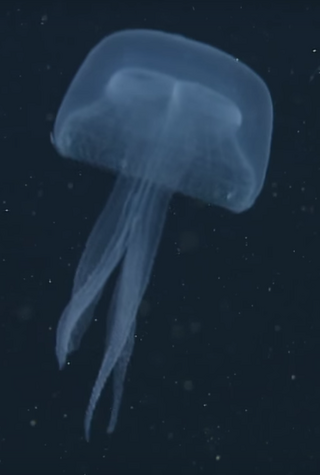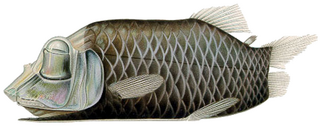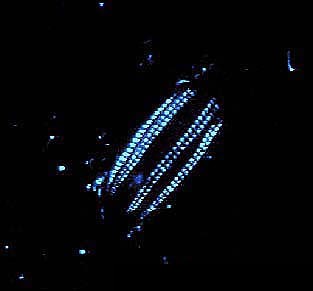
Ctenophora comprise a phylum of marine invertebrates, commonly known as comb jellies, that inhabit sea waters worldwide. They are notable for the groups of cilia they use for swimming, and they are the largest animals to swim with the help of cilia.

Stellamedusa is a genus of jellyfish. The genus is monotypic with a single species recognized, Stellamedusa ventana.

Beroidae is a family of ctenophores or comb jellies more commonly referred to as the beroids. It is the only known family within the monotypic order Beroida and the class Nuda. They are distinguished from other comb jellies by the complete absence of tentacles, in both juvenile and adult stages. Species of the family Beroidae are found in all the world's oceans and seas and are free-swimmers that form part of the plankton.

Lobata is an order of transparent marine invertebrates belonging to the phylum of Ctenophora in the class Tentaculata, and are commonly referred to as comb jellies or sea gooseberries. There are currently 19 extant known species in the order of Lobata. Members of Lobata exhibit a compressed body in the vertical plane and a pair of oral lobes. They are known to inhabit marine pelagic surfaces and the marine shores.

Bathocyroe fosteri is a species of lobate ctenophore found at intermediate depths in all the world's oceans. The species is very common and abundant near the Mid-Atlantic Ridge. It is bioluminescent, and is typically observed hanging motionlessly in an upright or inverted posture although it can flap its oral lobes to swim. This deep-sea comb jelly is named for Alvin (DSV-2) pilot Dudley Foster, who collected the first specimens.

Barreleyes, also known as spook fish, are small deep-sea argentiniform fish comprising the family Opisthoproctidae found in tropical-to-temperate waters of the Atlantic, Pacific, and Indian Oceans.

The Monterey Bay Aquarium Research Institute (MBARI) is a private, non-profit oceanographic research center in Moss Landing, California. MBARI was founded in 1987 by David Packard, and is primarily funded by the David and Lucile Packard Foundation. Christopher Scholin serves as the institute's president and chief executive officer, managing a work force of approximately 220 scientists, engineers, and operations and administrative staff.

Tiburonia is a genus of jellyfish in the family Ulmaridae. It was reported in 2003, following the discovery of its only species yet identified, Tiburonia granrojo. It was discovered by a crew from MBARI led by George Matsumoto. Pieces of the medusae were collected for morphological analysis, which eventually led to sequencing and taxonomic identification. The discovery of this organism led to not only a new species, but a new subfamily of Ulmaridae, called Tiburoniinae. Its genus was named Tiburonia after the ROV the crew were using, called Tiburon, meaning "shark" in Spanish. Because of this ROVs distinct maneuverability, all angles of the organisms were able to be observed, which is particularly important to the study of gelatinous pelagic invertebrates. Its species name was originally to be called "big ugly", but Kirsten Matsumoto, George Matsumoto's wife, raised objections to this name, and renamed it granrojo, meaning "big red" in Spanish, leading to its English-language name, the Big Red Jellyfish.

Ocyropsis is a genus of Ctenophores, which are commonly known as Comb Jellies. Ocyropsis belong to the family of Ocyropsidae. Ocyropsis possesses two large lateral muscular lobes and four auricles, and appear pale and translucent in color. Ocyropsis habitat is not precise as their gelatinous composition can make it difficult to study. They have been found in warm and cold waters. Unlike other, slow swimming Ctenophores, Ocyropsis are efficient in evading their predators. They use their oral lobes for additional propulsion and a secrete luminous mucous in efforts to evade predators. The muscular oral lobes of the Ocyropsis are used to grab its prey, and then moved to the prehensile mouth for absorption.

Pleurobrachia bachei is a member of the phylum Ctenophora and is commonly referred to as the Pacific sea gooseberry. These comb jellies are often mistaken for medusoid Cnidaria, but lack stinging cells.

Mertensia ovum, also known as the Arctic comb jelly or sea nut, is a cydippid comb jelly or ctenophore first described as Beroe ovum by Johan Christian Fabricius in 1780. It is the only species in the genus Mertensia. Unusually among ctenophores, which normally prefer warmer waters, it is found in the Arctic and adjacent polar seas, mostly in surface waters down to 50 metres (160 ft).

The Venus girdle is a comb jelly in the family Cestidae. It is the only member of its genus, Cestum, and is also the largest of all known ctenophores.

Bolinopsis infundibulum, commonly known as the common northern comb jelly, is a species of comb jelly in the family Bolinopsidae. It is found in the northern Atlantic Ocean and was first described by the Danish naturalist Otto Friedrich Müller in 1776.

Pleurobrachia pileus is a species of comb jelly, commonly known as a sea gooseberry. It is found in open water in the northern Atlantic Ocean, the North Sea, the Baltic Sea and the Black Sea, and was first described by the Danish zoologist Otto Friedrich Müller in 1776.

Thalassocalyce is a genus of ctenophore, or comb jellies, known from the California Coast, Gulf of Mexico, and west north Atlantic. It is represented by a single species, Thalassocalyce inconstans, which is the only species in the family Thalassocalycidae and the order Thalassocalycida. T. inconstans is a pelagic ctenophore typically occurring in upper-mesopelagic depths, but has been observed at depths up to 3,500 m in Monterey Canyon.

Coeloplana astericola, the creeping comb jelly, is a species of benthic comb jelly from the tropical western Indo-Pacific region that lives as an episymbiont on starfish such as Echinaster luzonicus.

Beroe abyssicola is a species of beroid ctenophore, or comb jelly. It is largely found in deep waters in the North Pacific Ocean, and is common in Japan and the Arctic Ocean. A predator, Beroe feeds mostly on other ctenophores by swallowing them whole. Like other ctenophores, B. abyssicola has a simple nervous system in the form of a nerve net, which it uses to direct its movement, feeding, and hunting behaviors.

Euplokamis is a genus of ctenophores, or comb jellies, belonging to the monotypic family Euplokamididae. It shares the common name sea gooseberry with species of the genus Pleurobrachia. After being originally described by Chun (1879), the family Euplokamididae was expanded by Mills (1987) due to the discovery of a new species, Euplokamis dunlapae. Further research indicated that Euplokamis should be identified from Mertensiidae due to the rows of combs and some compression. They may also be distinguished from the genus Pleurobrachia due to their more elongated shape. Additionally, various adaptations of Euplokamis have been observed such as the use of tentacles for movement/feeding, a complex nervous system, and bioluminescent capabilities. Other characteristics including a defined mesoderm, lack of stinging cells, developmental differences, and symmetry supported the reclassification of these organisms.
Beroe gracilis is a species of comb jelly in the family Beroidae. It is a free-swimming species found in the North Sea, the Atlantic Ocean and the Mediterranean Sea.


















